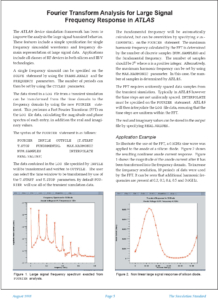Fourier Transform Analysis for Large Signal Frequency Response in ATLAS
The ATLAS device simulation framework has been to improve the analysis the large signal transient behavior. These features include a simple specification for single frequency sinusoidal waveforms and frequency domain representation of large signal data. Applications include all classes of RF devices in both silicon and III-V technologies.
A single frequency sinusoid can be specified on the SOLVE statement by using the TRANS.ANALY and the FREQUENCY parameters. The number of periods can then be set by using the CYCLES parameter.
The data stored in a LOG file from a transient simulation can be transformed from the time domain to the frequency domain by using the new FOURIER statement. This performs a Fast Fourier Transform (FFT) on the LOG file data, calculating the magnitude and phase spectra of each entry, in addition the real and imaginary values.
The syntax of the FOURIER statement is as follows:
FOURIER INFILE OUTFILE [T.START T.STOP FUNDAMENTAL MAX.HARMONIC NUM.SAMPLES INTERPOLATE REAL.VALUES]
The data contained in the LOG file specified by INFILE will be transformed and written to OUTFILE. The user can select the time window to be transformed by use of the T.START and T.STOP parameters. By default FOURIER will use all of the transient simulation data.
The fundamental frequency will be automatically calculated, but can be overridden by specifying FUNDAMENTAL on the FOURIER statement. The maximum harmonic frequency calculated by the FFT is determined by the number of discrete samples (NUM.SAMPLES) and the fundamental frequency. The number of samples should be 2![]() where n is a positive integer. Alternatively, the maximum harmonic frequency can be set by using the MAX.HARMONIC parameter. In this case, the number of samples is determined by ATLAS.
where n is a positive integer. Alternatively, the maximum harmonic frequency can be set by using the MAX.HARMONIC parameter. In this case, the number of samples is determined by ATLAS.
The FFT requires uniformly spaced data samples from the transient simulation. Typically in ATLAS however the time steps are not uniformly spaced. INTERPOLATE must be specified on the FOURIER statement. ATLAS will then interpolate the LOG file data, ensuring that the time steps are uniform within the FFT.



